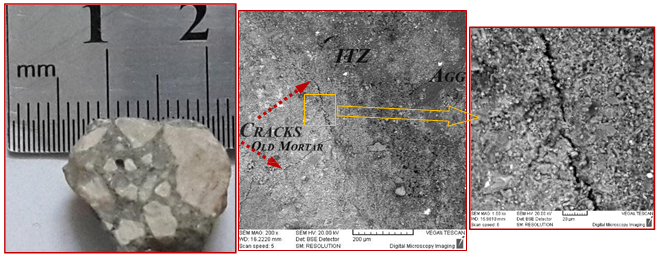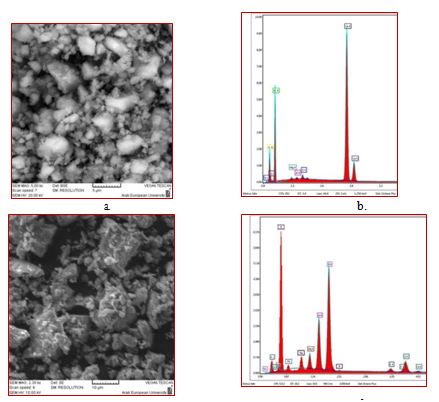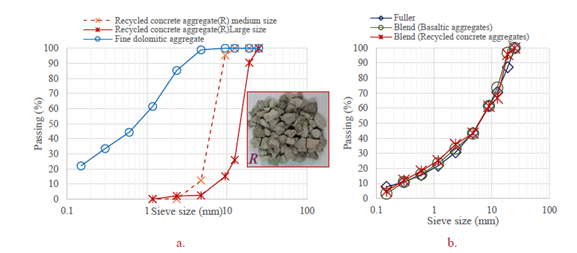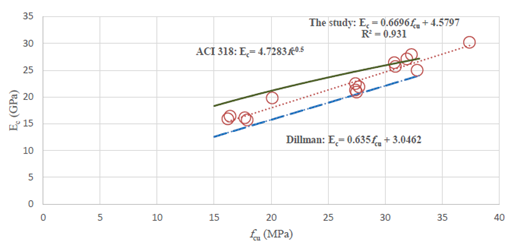MOJ
eISSN: 2572-8520


Research Article Volume 2 Issue 1
1Faculty of Scientific Research, Arab International University (AIU), Syria
2Faculty of Architectural Engineering, Arab International University (AIU), Syria
Correspondence: Aref M al-Swaidani, Faculty of Scientific Research, Arab International University (AIU), Syria
Received: November 01, 2016 | Published: January 23, 2017
Citation: al-Swaidani AM, al-Hajeh T. Production of greener recycled aggregate concretes using local supplementary cementing materials. MOJ Civil Eng. 2017;2(1):12-18. DOI: 10.15406/mojce.2017.02.00022
In the study, supplementary cementing materials (SCMs) have been added in an attempt to improve the performance of recycled aggregate concrete. The use of such eco-friendly materials could also promote a further greening practice in the concrete industry. The concrete performance was evaluated in terms of mechanical properties and concrete permeability. Mechanical properties investigated include compressive strength and modulus of elasticity of concrete. Water permeability, chloride penetrability have particularly been studied to evaluate the permeability properties. The results revealed that the use of SCMs could improve produce greater compressive and modulus of elasticity than those of the recycled aggregate concrete alone. Further, the results showed that permeability properties of recycled aggregate concrete have significantly been improved with addition of these SCMs. Basaltic aggregates were used for comparison and SEM analysis was employed as well.
Keywords: recycled concrete aggregates, permeability, green concrete, scms, durability
Many of towns have totally or partially been destroyed after five years of conflict in Syria. According to a report released by UN Economic and Social Council for Western Asia (ESCWA) in 2013, more than 1.2 million homes have been damaged or destroyed.1 Among cities that suffered from building destruction due to the ongoing events, Aleppo was ranked the first with more than a half million of totally or partially destroyed buildings, followed by Damascus countryside which half of its houses were also destroyed. However, the current real figure of the destroyed buildings could be significantly over that reported by ESCWA.1
The resulting rubble could produce tremendous discarded concrete. Hence, the recycled concrete aggregates (RCA) are expected to be inevitable building materials during the post-war rebuilding in the country. Compared to natural aggregate, RCA, however, has a higher tendency of water absorption due to the attached old cement mortar, resulting in a decline of strength and durability of recycled aggregate concrete (RAC) and limits its wider application. To overcome the weakness of RCA, much work has been carried out on improvement of RCA quality.2 This paper attempts to investigate the influence of adding SCMs on compressive strength and modulus of elasticity of RAC. Permeability properties of RAC such as water permeability and chloride penetrability have also been investigated. Some petro graphic, chemical and physical properties have been reported, as well.
The importance of the study can be summarized in the following points:
Materials
Obtaining concrete wastes from the completely or partially demolished homes has always been a logistic problem in the country. Therefore, coarse RCAs have been produced by crushing old concrete cubes (C25/30) used for compressive strength test. Fine recycled concrete aggregate was not considered for recycled aggregate concrete production because its application in structural concrete is generally not recommended.11,12 Figure 1 shows a macrograph of a coarse RCA particle produced from crushing old concrete cubes, accompanied by a SEM analysis.

Figure 1 A) Photograph of a coarse recycled aggregate particle; B) SEM of the particle: the old mortar and aggregate on both sides of the interfacial transition zone (ITZ) are shown.
The SCMs used are limestone which was quarried from Hama governance, about 200km north of Damascus, and volcanic scoria which was collected from Tel Shihan’ quarry, about 70km southeast of Damascus. SEM and EDX analysis of the limestone powder and volcanic scoria are presented in Figure 2. The chemical analysis of limestone and volcanic scoria used in the study is summarized in Table 1. This analysis was carried out by means of wet chemical analysis specified in EN 196-2 (1989). The total organic carbon (TOC) and clay contents of limestone have been determined in accordance with EN 13639 and EN 933-9, respectively.

Figure 2 SEM and EDX of the investigated SCMs. A) and B) limestone powder; C) and D) volcanic scoria.
Chemical composition (by mass, %) |
Materials |
||||
|---|---|---|---|---|---|
Recycled Concrete Aggregate |
Basalt Aggregate |
Volcanic Scoria |
Limestone Filler |
Cement |
|
SiO2 |
1.13 |
45.76 |
44.91 |
1.57 |
20.13 |
Al2O3 |
0.63 |
16.87 |
16.98 |
0.69 |
5.14 |
Fe2O3 |
0.24 |
14.39 |
8.64 |
0.33 |
3.2 |
CaO |
33.05 |
8.93 |
9.39 |
54.37 |
62.65 |
MgO |
19.81 |
6.61 |
8.87 |
0.43 |
2.33 |
Na2O |
0.1 |
2.64 |
2.76 |
0.02 |
0.71 |
K2O |
0.2 |
1.05 |
1.75 |
0.01 |
0.24 |
TiO2 |
0.1 |
2.53 |
0.9 |
0.07 |
0.15 |
Cl- |
0.02 |
0.01 |
0.01 |
0.05 |
|
SO3 |
0.02 |
- |
0.01 |
0.01 |
2.35 |
Loss on ignition |
44.59 |
1.1 |
0.36 |
42.22 |
2.39 |
Insoluble residue |
0.1 |
5.01 |
- |
0.69 |
|
Table 1 Chemical composition of the materials used in the concrete mixes
Crushed Basaltic aggregates extracted from As-Swaida’a region, about 100km southeast of Damascus, have also been used for comparison. The chemical analysis of the aggregates used in the study is listed in Table 1. This analysis has been carried out by means of X-Ray fluorescence. The cement used in the experiments was obtained from Adra Cement Plant, Damascus, Syria. Chemical analysis of cement is shown in Table 1. Limestone and volcanic scoria have separately been ground to 4200±100cm2/g Blaine fineness, while the clinker and gypsum were underground into 3600±50 cm2/g. Four binder samples were prepared; one plain Portland cement CEM I (control) (EN 197-1), two binary binders with one replacement levels of 10% limestone filler or 25% volcanic scoria (EN 197-1) and one ternary binder containing both limestone filler and volcanic scoria with replacement levels of 10% and 25%, respectively. All replacements were made by mass of cement.
Five concrete mixes were prepared. The first mix was prepared using basaltic aggregate. The second mix was prepared using 100% coarse RCA and fine dolomite aggregate with CEM I added, whereas the third to the fifth mixes were prepared using 100% coarse RCA and fine dolomite aggregate with addition of 10% LF, 25% VS and 10% LF + 25% VS as cement replacement, respectively. The grading of aggregate mixtures was kept nearly close to fuller’s curve (Dmax=25mm) for all concrete mixes. Some physical properties and grading of the aggregates are illustrated in Table 2 & Figure 3, respectively. Their quantities in 1m3 concrete mix based on oven-dry condition are summarized in Table 3. All concrete mixes were designed to have a water-binder ratio of 0.6 which is a customary value in the local concrete plants. All concretes were designated as shown in Table 3. Nine concrete cubes (150 mm) and three concrete prisms (150×150×450mm) were cast for each of mixture type and curing age for the determination of compressive strength and modulus of elasticity, respectively. Further, three concrete cubes (150mm) were cast for each of mixture type and curing age for the determination of water permeability. Three concrete cylinders (100 mm×200 mm) for each of mixture type and curing age were cast for evaluating the concrete penetrability of chloride ions. One slice of 100 mm in diameter and 50mm in thickness was cut from the middle portion of each concrete cylinder specimens for using in the chloride penetrability test.

Figure 3 particle size distributions of the investigated RCA (left) and fuller curve with the blends (right)
Pozzolan activity index (%) (ASTM C618) |
79 (at 7 days) |
90 (at 28 days) |
||||
|---|---|---|---|---|---|---|
Characteristic |
Fine dolomite aggregate |
Recycled concrete aggregates |
Basaltic aggregates |
|||
Medium |
Large size |
Fine |
Medium |
Large |
||
size |
size |
size |
||||
Specific gravity |
2.7 |
2.39 |
2.43 |
2.73 |
2.78 |
2.79 |
Absorption (%) |
1.5 |
4.79 |
5.14 |
1.54 |
1.34 |
1.34 |
Sand equivalent (%) (ASTM D 2419) |
76 |
87 |
||||
Los Angeles (%) (ASTM C33) |
33.9 |
17.3 |
||||
Na2SO4 soundness (%) (ASTM C 88) |
1.9 |
0.41 |
||||
Table 2 Some characteristics of the different aggregates used in the experiments
Concrete mix |
Fine aggregates |
Medium-Size aggregates |
Large Size aggregates |
PC (kg) |
LF (kg) |
VS (kg) |
Water (kg) |
Total weight |
|
BBC |
718 |
220 |
879 |
350 |
0 |
0 |
210 |
2377 |
|
Plain RAC |
676 |
284 |
705 |
350 |
0 |
0 |
210 |
2225 |
|
RAC-LF |
674 |
282 |
702 |
315 |
35 |
0 |
210 |
2218 |
|
RAC-VS |
673 |
282 |
701 |
262.5 |
0 |
87.5 |
210 |
2216 |
|
RAC-LF-VS |
671 |
281 |
699 |
227.5 |
35 |
87.5 |
210 |
2211 |
|
Table 3 Ingredients of the prepared concrete mixes
Methods
The compressive strength development has been determined on 150 mm cubic concrete specimens at ages of 2, 7, 28, 90 days, in accordance with ISO 4012. The static modulus of elasticity of concrete was determined in accordance with ASTM C 469. The specimen was instrumented with three strain gauges. The test was carried out on the concrete specimens at the ages of 7, 28 and 90 days. Concrete permeability measured in terms of depth of water penetration13 has been carried out as per the standard EN 12390-8 after 7, 28 and 90 days curing. The rapid chloride penetrability test (RCPT) has been conducted in accordance with ASTM C 1202. The set-up of RCPT is illustrated in Figure 4. The total charge passed through the sample, in coulombs, is determined by calculating the area under the current–time plot during the 6-h test period. Three cylinder specimens of each concrete mix were tested after 7, 28 and 90 days curing.
Properties of RCA and SCMs
As seen from Table 2, the water absorption (%), Los Angeles value (%) and Na2SO4soundness (%) of coarse RCA were 5%, 33.9% and 1.9%, respectively. These expected results for coarse RCA can mainly be attributed to the residue of mortar adhering to the original aggregate.14 The coarse RCA are less hard and resistant to freezing than natural aggregates (i.e. basaltic aggregates), but values of Los-Angeles (33.9% on average) and soundness (1.9% on average) remain acceptable with regards to the allowable 45% & 12% limits usually required, respectively (ASTM C33).
On the other hand, the chemical composition of limestone powder has been found to be 55% CaO (CaCO3 ratio is about 97%) with a loss on ignition value of 43%. The total organic content (TOC) and clay content of the studied limestone has been determined as 0.36% & 0.56%, respectively. According to EN 197-1 standard, the CaCO3 ratio of limestone employed in the production of blended cement should be at least 75%, and the clay content of limestone should not exceed 1.2%. Based on the analysis results, the studied limestone can be used as ingredient in cement production. In addition, volcanic scoria satisfied the standards requirements for such a material by having a combined SiO2, Al2O3 and Fe2O3 of more than 70%, a SO3 content of less than 4% and a loss on ignition of less than 10% (ASTM C618:2001). SiO2 reactive content is more than 25%, as well (EN 197-1) Furthermore, volcanic scoria has a strength activity index with Portland cement (PC) higher than the values specified in ASTM C618 (2001).
Compressive and splitting strength of concretes
The development of the compressive strength with age of basaltic-based concrete (BBC) and recycled aggregate concrete (RAC) with and without SCMs is illustrated in Figure 5. As expected, the compressive strengths of concrete increased with curing time, but with a different rate of strength gain. In general, there is a 16% decrease in 28 days-compressive strength of plain RAC as compared to BBC. This observation is similar to that reported in the literature 15-18 and departs from that of other researchers 19-21 who observed that the decrease in strength ranged from 25 to 45%. The insignificant decrease could be attributed to the use of crushed concrete cubes free from impurities or unwanted substances.
The relatively lower compressive strengths of plain RAC, as illustrated in Figure 5, could be explained by the heterogeneity and porosity of recycled concrete aggregates. These properties have a negative influence on RAC quality due to the following: (i) the increased concrete porosity which could mainly be attributed to the residue of mortar adhering to the original aggregate (ii) the weak aggregate-matrix interfacial bond 22-24 and (iii) the fissures which might be formed in recycled aggregates during processing thereby rendering the recycled aggregate having weaker structure.25 This explanation has been confirmed by SEM analysis of the recycled aggregate used in the experiments, as shown in Figure 1.
By contrast, the addition of SCMs enhanced the compressive strengths to reach values equal or even bigger than those of RAC. This could be explained by the more compacted interfacial transition zone (ITZ) when using fine additives; thereby the bond between the hydrated blended cement and aggregate becomes stronger. Contrary to expectation, the positive influence of adding volcanic scoria might be clearly observed only after 7 days curing, as shown in Figure 5. This could be attributed to the relatively high fineness of natural pozzolans (i.e. 4200 cm2/g) which increases their surface area, resulting in higher activity.26
Modulus of elasticity
Figure 6 shows the secant modulus of elasticity at three different curing times (x-axis) for the concretes tested. The development of static modulus of elasticity of RAC without and with SCMs has almost the same trend as in case of compressive strength as shown in Figure 6. The highest modulus of elasticity was found for control mix which was 25.0 GPa after 28 days curing and it was higher than that of RAC by about 19%. The decrease in modulus of elasticity of RAC could mainly be due to the significant quantity of cement mortar attached to RA which makes the concrete more porous and less stiff .27-29 Such a reduction was also reported by other researchers.29-31
The addition of SCMs increased the modulus of elasticity of concrete. The corresponding increase of the 7 days-cured concrete was 10%, 15% and 20% for the concrete mixes prepared with LF, VS and LF+VS, respectively. This could be attributed to the more compacted concretes when adding fine and pozzolanic additives.3,4 The relationship between the compressive strength and the modulus of elasticity was established, as shown in Fig. 12. The equations suggested by ACI 318 and Dillman32 for the modulus of elasticity in terms of compressive strength are also shown. It is clear that the ACI equation slightly overestimates while the Dillman equation32 underestimates the modulus of elasticity of concrete prepared with recycled aggregates.

Figure 7 Relationship between the cubic compressive strength and the modulus of elasticity of the studied concrete mixes.
Water permeability of concrete
Figure 8 shows the water penetration depth test results for BBC and RAC without and with SCMs. As expected, plain RAC was more permeable than BBC and RAC with additives. For instance, 28 days-cured RAC had a water penetration depth 81 mm, showing an increase of about 130% compared to the BBC mix. Such an increase, as agreed by Limbachiya et al.33 and Gholamreza et al. work34 could be due to the presence of adhered mortar on RCA in the mixture. This adhered mortar which is characterized by its higher porosity and its higher water absorption served as potential conduit for water transport.35 The higher permeability of RAC indicated a reduction in durability when it is used.
Plain RAC specimens were found to be permeable even after 90 days curing. However, as shown in Figure 8, Adding SCMs has significantly reduced the penetration depths even after shorter curing times. The reason for the reduced permeability of RAC-VS and RAC-LF-VS is believed to be due to the following: i) the pozzolanic reaction which might occurred between SiO2 reactive from volcanic scoria and calcium hydroxide, Ca(OH)2 released during cement hydration. This reaction produces additional C-S-H gel which fills up the micro pores in ITZ, thus leading to higher resistance to water penetration; ii) the filling effect of the additives which might block the microspores and fissures especially at ITZs.
Rapid Chloride Penetrability Test (RCPT)
Figure 9 the total charge passed for plain RAC, as illustrated in Figure 9, was always greater than those for BBC by about 91%, 63%, and 85% after 7, 28 and 90 curing days, respectively. The high level of charge passage (˃4000 coulombs) in RAC may be attributed to the porosity of recycled concrete aggregates. Unlike natural aggregate, the (RCA) itself imposes the higher porosity arising from the mortar debris on the surface of the (RCA) particles, which could substantially enhance the ionic mobility.9 However, the concretes containing both limestone filler and volcanic scoria showed the best performance among all the specimens. The improvement in resistance to chloride penetration could be due to the relatively high compacted structure in these specimens especially in ITZs and their reduced electrical conductivity. This result is in good agreement with the findings in the literature.7,36,37
The addition of volcanic scoria alone also significantly decrease the chloride ion penetration. The formation of more hydration products as volcanic scoria hydrated might block the ingress path of chloride ions, thus enhancing the resistance to chloride penetration.3 Furthermore, the results obtained clearly indicate that the water permeability data cannot effectively be used to predict the concrete resistance to the chloride-ion penetration and vice-versa, especially when limestone filler is used in concrete. Although the limestone filler basically acts as filler, its use in the plain RAC did not significantly decrease the concrete chloride ion permeability, as shown in Figure 9. This may be related to the higher level of OH- ions present in the pore fluid of the concrete made with limestone powder.38 These ions act as a supporting electrolyte because of its higher ionic conductivity than other ions present in pore fluid (K+, Na+ and Ca2+).38
Finally, it is worthwhile to mention that the results obtained were confirmed by SEM analysis as shown in Figure 10. It was clearly noted from Figure 10A, the presence of micro cracks and the lack of compactness in the plain RAC specimen. On the other hand, more compacted microstructures particularly at ITZs were observed in the RAC containing SCMs as clearly seen in Figure 10B. No apparent fissures were detected. Chloride ion penetrability (Coloumbs) Figure 9. Chloride ion penetrability of the tested concretes with curing age this compacted microstructure may be attributed to the following: i) the filler effect of additives. This effect is likely because both limestone filler and ground volcanic scoria were finer than the Portland cement, so they could fill the micro pores in the ITZs around aggregates; ii) despite that limestone filler has no pozzolanic property, its fine particles could contribute to form new hydration products, like carboaluminate phase, which might fill the micro cracks and thus reduce the pore ratio.39 This carboaluminate phase might be of greater importance particularly in binders containing supplementary cementitious materials of significant contents of aluminates such as volcanic scoria similar to that used in the present investigation;40 iii) the pozzolanic reaction between the glassy phase in natural pozzolans and the CH released during cement hydration. The continuation of this reaction and the formation of further cementitious products such as C-S-H and C-A-S-H 3 may block the fissures originally present in RCA contributing to make the concrete denser and less permeable to water and chloride ions.
None.
The author declares no conflict of interest.

©2017 al-Swaidani, et al. This is an open access article distributed under the terms of the, which permits unrestricted use, distribution, and build upon your work non-commercially.